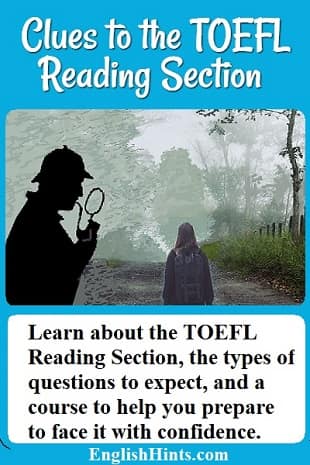the TOEFL Reading Section (& Course)
Does the thought of the TOEFL reading section worry you? How can you learn the vocabulary and reading comprehension skills to get the score you need?
Solve the “mystery” of English reading and vocabulary with this course on Clues to the TOEFL Reading section. This short course will help you gain the skills and confidence you need to get a better score.
You will study the test's structure and what the examiners are looking for with each type of test question. Then you'll discover the secrets to answer each kind of question quickly and confidently.
First, learn a little about the TOEFL Reading Section. (This information is new, as there were major changes to the test in mid 2019.)
Find out why you might want to take a course, or just to study it on your own, with the materials provided by ETS, the test's makers.
The TOEFL Reading Section Questions
The TOEFL Reading Section is the first part of the TOEFL Exam. It includes 3 or 4 reading passages with 10 questions each, and it will take 54-72 minutes.
There are several different types of questions. Most are multiple choice, most often checking your understanding of the passage or a word in it. (Comprehension/general information and vocabulary questions are usually more than half the questions.)
There are also negative questions. For example, a question may give several related facts and ask which was NOT mentioned in the passage.
Sometimes multiple choice questions may ask about the author's purpose in writing. Other common questions ask what you can infer from what you have read, or which noun a pronoun in the passage refers to.
There are two other types of questions. You may get one question per passage showing a sentence and asking which of four possible places in a paragraph it should go. This is checking how well you understand the organization of the passage.
(It also checks your understanding of sequence markers and transition words: although, even if, before, later, as a result, etc.}
Each passage also will include one "reading to learn" question with more possible choices and possible answers. (These are worth more than one point if you provide all the correct information.)
These questions may ask you to put information from the passage into categories. They may ask you to choose the most important points for a summary of the passage instead.
The TOEFL organization (ETS) recommends asking yourself (or a friend) questions as you practice reading in English.
It also suggests that you pay attention to common word roots and affixes. Notice main ideas and supporting details. Also be sure to practice skimming, scanning, and summarizing what you read.
These are all very important practice activities. You can do them on your own or with a friend. You can also learn more about them on EnglishHints.
See Improve Reading Skills, information on recognizing word parts, especially Word Families, Common Prefixes, and 50+ Word Roots) Reading Comprehension Practice, etc.
You can also study them step by step in the course below. That will make your preparation simpler. The course practices all these skills and each question type.
What Will You Learn in the TOEFL Reading Course?
In the course's 12 units (to study and practice with each type of reading test question), you will learn and practice how to
- skim the reading selection to find the main ideas and most important details, then scan it for the answers to individual questions,
- make inferences and recognize the implications of ideas that are not clearly stated,
- identify the best answers to different types of questions, and
- increase your reading speed.
You will also learn to
- recognize good (and poor) restatements of ideas, and practice paraphrasing and summarizing skills,
- recognize the nouns that pronouns refer back to, even when they are not close to each other, and
- identify unknown words and use websites that can increase your academic vocabulary.
There is a quiz after each lesson with a reading passage and questions like the ones on the TOEFL Reading Test. Each quiz practices the question types demonstrated in that lesson, and often a few others.
In the middle and at the end of the course there are longer tests of 12-14 questions. These closely resemble a reading passage and its questions in the actual test.
There are also full explanations and links to several sites for vocabulary practice. (Find out which vocabulary that is important to learn first. There are sets of 25-30 words with definitions to practice with flashcards and games.)
Bonuses and Extra Help
A very important bonus is the private Facebook group. You can discuss the test and your experiences with other students. You can also ask me (or your fellow students) about anything you’re not sure about.
(You can send a private message to me if that would ever be better, and I will answer as quickly as possible. If a lesson is confusing or missing something you need, I will change or add to it.)
I’ll work with you to help you prepare—and to improve your English. That can open so many doors to future opportunities.
If you want to take any of the other courses in the EnglishHints Academy, you can get a 25% discount on the second course. Let me know on the contact form below.
You can also take this course with a friend or two for a 25% discount. That makes it easy for you to study and practice together. Again, send me a message.

Your satisfaction guaranteed. Please contact me if you have any problems or questions. If you are not happy with this course, please contact me for a full refund (or a credit plus 10% on a different course if you prefer.)
If you find the course helpful please take a moment to let me know and to share it. Thanks!
For more information on courses to prepare for exams like the TOEFL, see Mastering English Test Vocabulary.
